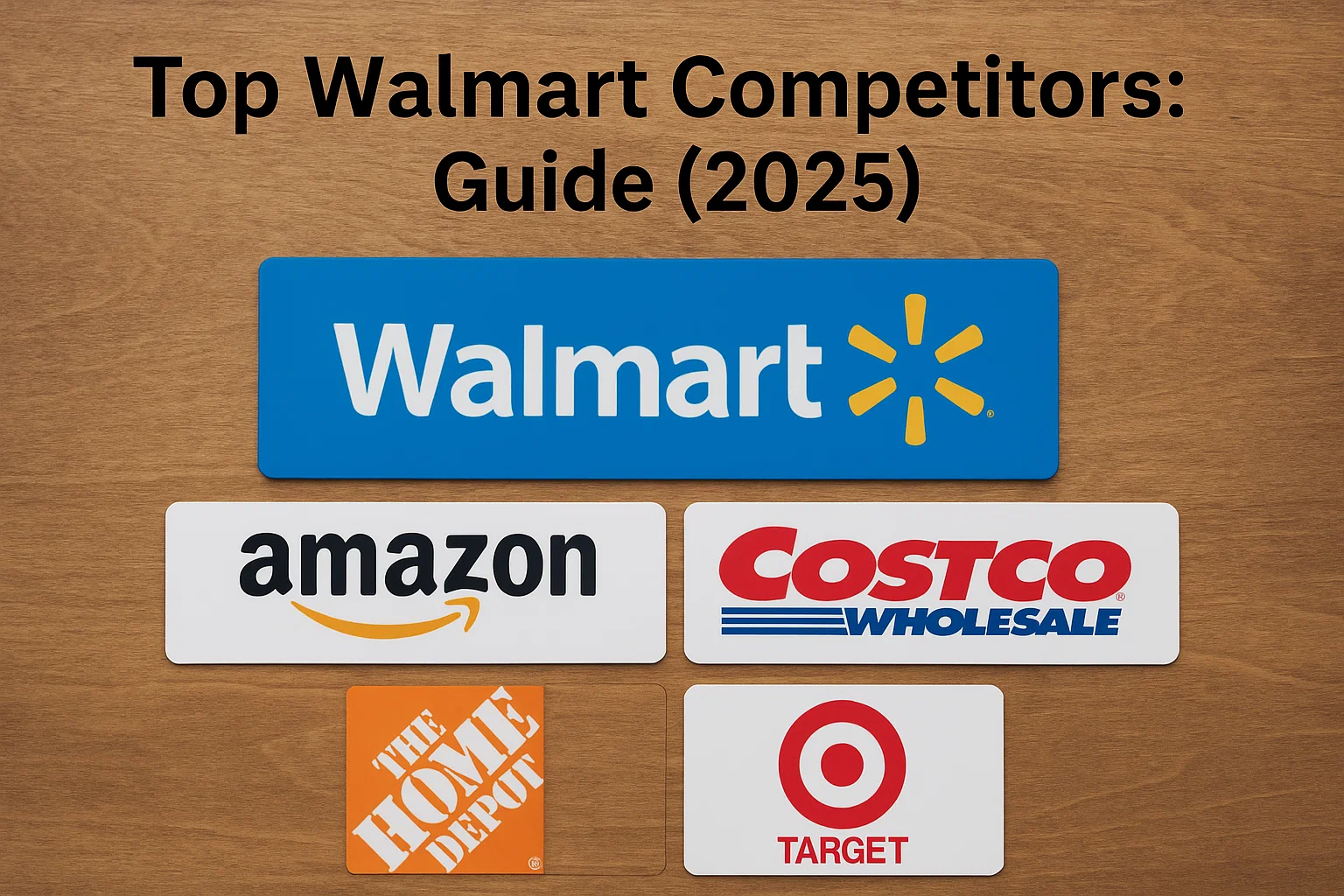Walmart stands as one of the most dominant retail forces globally—serving millions of customers daily through both its physical stores and online platforms. From groceries and household goods to electronics and apparel, Walmart’s diverse offerings and aggressive pricing strategy have made it a formidable player in the retail world. However, in the ever-evolving landscape of eCommerce and retail, Walmart isn’t without competition. A growing number of Walmart competitors—ranging from online marketplaces like Amazon to niche players like Etsy—are rapidly gaining ground. Whether you’re a seller looking to expand beyond Walmart or an entrepreneur researching the best platform to launch your store, understanding the Walmart similar companies is critical.
In this guide, we dive deep into the top Walmart competitors in 2025, comparing their strengths, weaknesses, and what they bring to the table. From pricing strategies to product range and logistics, this blog helps you identify where your brand fits best—and how to compete effectively.
Why Study Walmart’s Competitors?
If you’re planning to start or scale your eCommerce business, analyzing Walmart’s competitors isn’t just smart—it’s essential. Here’s why:
Market Insight & Strategic Positioning
Studying Walmart similar companies gives you valuable insight into the broader retail and eCommerce market. You’ll understand where consumer demand is shifting, what features shoppers prioritize, and how different platforms are adapting.
Product & Category Opportunities
Different platforms attract different customer segments and product categories. Etsy favors handmade and vintage goods, while Costco is built on bulk pricing and member loyalty. Knowing this helps you align your inventory with the platform best suited for it.
Pricing and Fulfillment Benchmarks
Walmart is known for everyday low pricing—but that doesn’t mean it’s always the cheapest or fastest. Competitors like Amazon offer faster fulfillment through FBA, and Target has its own customer loyalty programs. Studying these elements allows sellers to stay competitive in areas that matter most.
Diversification and Risk Management
Relying solely on one platform—especially one as powerful as Walmart—can be risky. Understanding your options among Walmart competitors enables you to diversify your sales channels, reach new customers, and reduce dependency on any single marketplace.
If you’re just starting out with Walmart, check out our detailed guide to learn how to sell products on Walmart.
Walmart Competitors: What Are The Walmart Similar Companies?
Understanding who Walmart is up against reveals crucial insights for entrepreneurs, eCommerce professionals, and businesses aiming to identify gaps or opportunities in the retail landscape. Walmart isn’t just a store — it’s a hybrid juggernaut blending physical retail, aggressive pricing, private labeling, and eCommerce efficiency. But even a giant has competitors.
Here’s a deep analysis of the top Walmart competitors across categories like general retail, online marketplaces, discount chains, niche platforms, and more.
Amazon
Business Model:
Amazon is the world’s largest online retailer and cloud services provider. It operates on a massive third-party marketplace model (50%+ of its sales come from third-party sellers) while also selling its own inventory (first-party sales).
Strengths:
Logistics Dominance: Fulfillment by Amazon (FBA) allows sellers to leverage Amazon’s fast shipping and warehousing.
Customer Loyalty: Amazon Prime offers fast shipping, streaming, and perks — cultivating retention.
Tech Superiority: From Alexa to personalized recommendations, Amazon integrates AI and data science in every user interaction.
Weaknesses:
Can be extremely competitive and saturated for sellers.
High fees for fulfillment, storage, and advertising.
Less control over branding and customer data for sellers.
Compared to Walmart:
Walmart competes heavily in physical retail, offering convenience through local pickup and grocery services. However, Amazon leads in automation, logistics, and digital experience. Walmart is catching up with Walmart+ and better online shopping UX.
Strategic Insight:
If you’re looking to scale rapidly online with robust logistics and can handle competition, Amazon might be a better initial move than Walmart Marketplace. But integrating both gives access to broader audiences.
2. Alibaba (AliExpress)
Business Model:
Alibaba operates as a B2B and B2C hybrid platform. Alibaba.com caters to bulk buyers (wholesalers), while AliExpress allows global consumers to purchase products directly from Chinese manufacturers at low prices.
Strengths:
Cost Advantage: Sourcing from China provides unbeatable margins for resellers.
Supplier Diversity: Millions of manufacturers in nearly every product category.
Dropshipping Friendly: AliExpress integrates well with Shopify and WooCommerce.
Weaknesses:
Long shipping times (10–40 days) unless using local warehouses.
Varying quality standards.
Less trust with Western consumers than Walmart or Amazon.
Compared to Walmart:
Walmart is a direct-to-consumer brand with localized fulfillment and brand equity in the U.S. Alibaba serves more as a backend source for sellers who might then use platforms like Amazon or Walmart to retail products.
Strategic Insight:
Use Alibaba as a sourcing partner and Walmart as a sales channel. This pairing can drive major profits if supply chain and quality are handled correctly.
3. Etsy
Business Model:
Etsy is a niche marketplace specializing in handmade goods, vintage items, crafts, and unique collectibles. It’s a community-driven platform with strong support for independent creators.
Strengths:
Niche Loyalty: Etsy’s buyers value craftsmanship, personalization, and uniqueness.
Low Entry Barrier: Easier for artisans and creators to set up stores.
SEO-Friendly Listings: Etsy products often rank high in Google searches.
Weaknesses:
High competition in some categories (jewelry, prints).
Less scalable for mass-production businesses.
Not suitable for generic or mass-manufactured items.
Compared to Walmart:
Walmart’s audience is broader and less niche — it favors mass-market products. Etsy sellers thrive when selling story-driven, design-centric products.
Strategic Insight:
If you’re a craftsperson or create handmade products, start with Etsy. Once you validate demand, scale production and migrate successful items to Walmart Marketplace for mainstream sales.
4. Wish
Business Model:
Wish is a budget eCommerce marketplace targeting mobile users with impulse-friendly products at ultra-low prices. It connects Western consumers to Chinese suppliers.
Strengths:
Pricing: Among the lowest-cost platforms for end users.
Product Discovery: Gamified shopping experience encourages longer browsing.
Low Advertising Cost: Sellers can gain visibility at lower CPCs than Amazon.
Weaknesses:
Poor reputation for delivery time and product quality.
Low customer retention and high refund rates.
Limited seller protection policies.
Compared to Walmart:
Walmart is trusted and known for consistency. Wish is risky for long-term brand-building but may suit certain low-cost item sellers or test product ideas.
Strategic Insight:
Avoid Wish as a primary business unless you’re experimenting with high-margin, high-volume, unbranded goods.
5. Best Buy
Business Model:
Best Buy is a U.S.-based electronics retailer with strong in-store and online presence. Its core offerings include appliances, computers, smartphones, and services like Geek Squad.
Strengths:
Tech Expertise: Staff training and service departments outperform Walmart in electronics.
BOPIS (Buy Online, Pick Up In-Store): A seamless omnichannel experience.
Loyalty Programs: My Best Buy program provides incentives.
Weaknesses:
Limited product categories outside electronics.
Higher price perception.
Compared to Walmart:
Walmart sells more categories but doesn’t specialize in tech support. Best Buy wins when buyers want guidance, installation, or better warranties.
Strategic Insight:
Tech brands looking to scale offline and offer demos or installation services should prioritize Best Buy. For general electronics, Walmart offers better foot traffic.
6. eBay
Business Model:
eBay is a peer-to-peer and business-to-consumer platform that includes auctions, fixed-price sales, and refurbished goods.
Strengths:
Versatile Product Listings: New, used, rare, or niche items.
Global Reach: Ships to over 190 countries.
Lower Fees Than Amazon: Particularly for sellers of used goods or collectibles.
Weaknesses:
Trust and buyer quality issues.
Less visibility for new brands.
Complex feedback and rating systems.
Compared to Walmart:
Walmart offers a standardized retail model with consistent pricing and branding. eBay works better for unique or one-off products.
Strategic Insight:
Use eBay to offload returns, used inventory, or test niche items. Walmart should be the core retail platform for consistent product lines.
7. Dollar General & Dollar Tree
Business Model:
Both chains operate small-format stores selling household essentials, snacks, and seasonal items at deeply discounted prices.
Strengths:
Low Price Point: Items often under $5.
Rural Penetration: Thousands of locations in underserved areas.
Impulse Buys: Store layouts encourage quick decisions.
Weaknesses:
Limited product selection.
Less eCommerce presence compared to Walmart.
Compared to Walmart:
Walmart competes directly with these chains on price but offers more variety and better private-label quality.
Strategic Insight:
If you’re in the discount or essential goods space, Walmart gives you scale and online exposure that dollar chains can’t.
8. Target
Business Model:
Target operates as a general merchandise retailer with a focus on design-forward private labels, mid-tier pricing, and urban audiences.
Strengths:
In-House Brands: Popular lines like Good & Gather and Cat & Jack.
Store Aesthetics: Clean, modern, curated.
Strong Demographics: Appeals to Millennials and Gen Z with disposable income.
Weaknesses:
Slightly higher pricing than Walmart.
Fewer locations.
Compared to Walmart:
Target wins on design, branding, and user experience. Walmart wins on scale and affordability.
Strategic Insight:
If your product fits an upscale, stylish aesthetic, test it with Target buyers. Walmart is still better for mass appeal.
9. Costco
Business Model:
Costco is a membership-only warehouse club known for bulk sales, in-house brands, and low per-unit pricing.
Strengths:
High LTV Customers: Loyal and high-spending due to membership.
Efficient SKUs: Only best-sellers are stocked.
Strong In-House Label (Kirkland): Competes with national brands.
Weaknesses:
Membership barrier to entry.
Less product diversity.
Compared to Walmart:
Walmart serves everyday buyers in smaller quantities. Costco caters to families and small businesses looking for bulk value.
Strategic Insight:
Bulk-focused sellers should explore Costco partnerships. Otherwise, Walmart is more flexible for new or seasonal brands.
10. Kroger
Business Model:
Kroger is a grocery-first retailer with strong regional brands and private-label food items.
Strengths:
High Food Quality: Strong fresh departments and bakery.
Localized Branding: Tailored store formats by region.
Digital Coupons & Loyalty Apps: Strong customer retention.
Weaknesses:
Grocery-only focus.
Slower eCommerce scaling compared to Walmart.
Compared to Walmart:
Walmart offers groceries + general merchandise. Kroger may win in grocery quality and freshness in certain areas.
Strategic Insight:
If you’re a CPG or food brand, list with both platforms. Use Kroger for grocery branding and Walmart for mass-scale reach.
11. Home Depot & Lowe’s
Business Model:
These are the two largest home improvement stores in the U.S., catering to DIYers, homeowners, and contractors.
Strengths:
Contractor-Friendly: Bulk orders, pro accounts, credit options.
Specialty Inventory: Deep catalog for home and hardware.
In-Store Guidance: Staff often experts in their department.
Weaknesses:
Limited general merchandise.
Higher prices on basic items than Walmart.
Compared to Walmart:
Walmart sells small tools and DIY kits but doesn’t cater to professionals. Home Depot and Lowe’s are best for large-scale projects.
Strategic Insight:
If your product is DIY or home-related, these two platforms offer focused exposure. Use Walmart for broader lifestyle or garden tools.
A Seller’s Guide to Walmart’s Private Label Trends in 2025
Walmart Competitors: Conclusion
Walmart’s dominance in retail is undisputed, but it operates in a fiercely competitive landscape where global giants and niche players are constantly innovating. From Amazon’s logistical superiority to Target’s curated branding and Costco’s membership-driven model, each competitor presents a unique challenge — and opportunity.
For sellers and professionals exploring eCommerce or retail, understanding these competitors helps position your business more strategically. Whether you’re looking to partner with a platform, analyze market gaps, or benchmark pricing and services — these insights can shape smarter decisions in 2025 and beyond.
Discover which products perform best on Walmart Marketplace by checking out our guide on Walmart Best Selling Items: Top Products to Sell! Boost your sales with trending, high-demand items.
Walmart Competitors: FAQ'S
Who are Walmart's biggest competitors?
Walmart’s biggest competitors include Amazon, Target, Costco, and Kroger. Amazon is its top rival in eCommerce, Target competes on branding and private-label products, while Costco leads in bulk sales and membership loyalty. In the online space, eBay, Best Buy, and Alibaba are also key players depending on the product category.
What grocery stores are major competitors to Walmart?
The main grocery competitors to Walmart are Kroger, Costco, Aldi, Trader Joe’s, and Safeway. Each of these grocery chains competes with Walmart’s grocery section through better freshness, pricing in specific categories, or unique in-store experiences.
What are the strengths of Walmart?
Walmart’s key strengths include:
Price leadership due to economies of scale and efficient supply chains
Massive physical retail presence with over 10,000 stores worldwide
Strong private-label brands like Great Value and Equate
Omnichannel capabilities, including grocery pickup, delivery, and Walmart+ subscription service
Supplier partnerships that help keep costs low and product selection broad
These advantages make Walmart a powerful player across multiple customer demographics and categories.
Contact Us for Tailored Solutions – Stores Automation:
Ready to transform your Walmart store and achieve big wins? Contact us at Stores Automation for personalized solutions that leverage the power of automation for your business. Reach out to us at 302-204-8244 or via email at info@storesautomation.com. Sign up and Embark on the path to e-commerce success with Stores Automation – where small changes lead to big wins!





